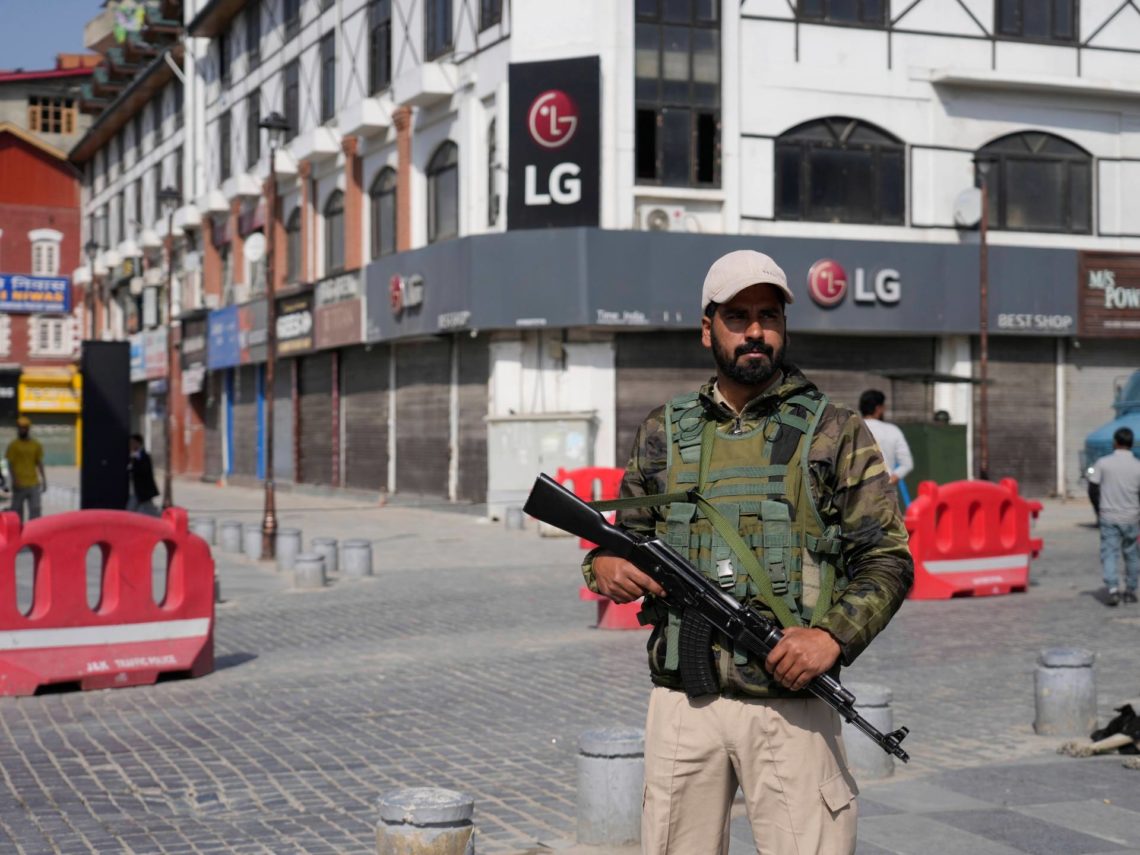New Delhi, India — Even as news of the deadliest attack on Indian-administered Kashmir’s tourists in decades filtered in on social media platforms and television screens, a message appeared on Telegram chats.
The Resistance Front (TRF), a little-known armed group that emerged in the region in 2019, claimed responsibility for the attack in which at least 26 tourists were killed and more than a dozen others were injured on Tuesday.
Armed rebels, who have been fighting for Kashmir’s secession from India, had largely spared tourists from their attacks in recent years. Tuesday’s killings changed that.
But what is TRF, and what influence does it wield in Kashmir? And what is at stake for the Indian administration in Kashmir now?
What happened on Tuesday?
On a pleasant, sunny afternoon in the Baisaran meadow of Pahalgam town in Kashmir, tourists came under attack from gunmen who emerged from a nearby forest.
The men armed with automatic rifles shot at least 26 tourists dead and injured several others. All those killed were men.
India’s home minister, Amit Shah, reached Srinagar, the summer capital of the disputed region, as condolences poured in from world leaders, including United States President Donald Trump and Russian President Vladimir Putin. Indian Prime Minister Narendra Modi wrote on social media that “those behind this heinous act will be brought to justice … they will not be spared!”
By then, TRF had claimed responsibility for the attack, even as the armed attackers who carried out the killings remained on the run.
What is TRF?
In a message that appeared on Telegram, TRF opposed the granting of residency permits to “outsiders”, who critics say could help India change the demography of the disputed region. “Consequently, violence will be directed toward those attempting to settle illegally,” it said.
Though the targets of the attack were tourists — not newly arrived residents making Kashmir their home — the group’s choice of Telegram to claim responsibility did not surprise security officials.
TRF is still, at times, referred to as “the virtual front” inside the security apparatus in Kashmir, for that is how it started.
After the Indian government unilaterally revoked Kashmir’s partial autonomy in August 2019 and imposed a months-long clampdown, the group first took shape by starting messaging on social media. In reorganising Kashmir, the government also extended domicile status, which allows land owning rights and access to government-sponsored job quotas, to non-locals — the purported justification for the Pahalgam attack.
The name The Resistance Front is a break from traditional rebel groups in Kashmir, most of which bear Islamic names. This, Indian intelligence agencies believe, was aimed at projecting “a neutral character, with ‘resistance’ in name focused on Kashmiri nationalism”, said a police officer, who has worked on cases involving armed groups for nearly a decade, requesting anonymity.
However, Indian officials have consistently maintained that, in reality, TRF is an offshoot — or just a front — of the Lashkar-e-Taiba, a Pakistan-based armed group. India says Pakistan supports the armed rebellion in Kashmir, a charge denied by Islamabad. Pakistan says it provides only diplomatic and moral support to the Kashmiri people. It also condemned the attack on tourists in Pahalgam.
Some Indian officials said they believe Tuesday’s attack may actually have been the handiwork of the Lashkar-e-Taiba, with TRF fronting responsibility to muddy India’s investigations into the killings.
Has TRF carried out attacks in the past?
By 2020, the group started taking responsibility for minor attacks, including targeted killings of individuals. Its recruits consisted of fighters from an amalgam of splinter rebel groups. Since then, Indian security agencies have busted multiple groups of TRF fighters.
But the group survived and grew.
By 2022, a majority of the armed fighters killed in gunfights in Kashmir were affiliated with TRF, according to government records. TRF members were increasingly using small arms such as pistols to carry out targeted killings, including those of retired security personnel and people accused of being informers.
The group also made headlines that year after it named Kashmiri journalists on a “traitor hit list” for allegedly colluding with the Indian state. At least five of the named journalists resigned immediately, as there is a history of such attacks. Shujaat Bukhari, a prominent Kashmiri journalist and editor of the Rising Kashmir publication, was assassinated on June 14, 2018, outside his office in Srinagar. The Kashmir police have attributed the killing to the Lashkar-e-Taiba.
In June 2024, TRF also claimed responsibility for an attack on a bus carrying Hindu pilgrims, killing at least nine people and injuring 33, in Jammu’s Reasi area. The bus had plunged into a gorge during the attack.
How is TRF different?
As TRF made its mark with its deadly attacks, it also used a mix of old and new strategies. Its English name stood out, as did its social media usage. But in other ways, it relied on more traditional techniques.
Before TRF’s arrival, Kashmiri rebel commanders had, since 2014, increasingly adopted more public personas. Their groups would post videos on social media of their commanders casually walking through apple orchards, playing cricket, or riding a bike in Srinagar. This social media outreach led to a surge in recruitment. Among the commanders who adopted this method was Burhan Wani, whose killing in July 2016 led to an uprising, during which more than 100 civilians were killed in street protests.
But after the 2019 crackdown, this approach no longer worked. TRF fighters, the newcomers on the scene, returned to tried and tested ways. “The faces were again hidden; the number of attacks fell, but the intensity became sharper,” said the police officer who requested anonymity.
Under the leadership of Mohammad Abbas Sheikh, one of the oldest Kashmiri fighters — he is reported to have joined the rebellion in 1996 — the group focused its attacks on Srinagar.
After his killing in 2021, and the killings of many other armed rebels in the subsequent year, TRF retreated with its fighters to jungles higher up in the mountains, a central intelligence official said on condition of anonymity.
In January 2023, the Indian government declared TRF a “terrorist organisation”, citing the recruitment of rebels and smuggling of weapons from Pakistan into Kashmir.
As more and more TRF fighters were killed by security agencies, their numbers dwindled. The rebels, according to the police and intelligence officials, were well trained but largely stayed in their high-altitude hideouts.
What does the attack mean for Modi’s Kashmir policy?
Yet, if Indian security and intelligence agencies were caught off guard by the attack, some experts believe that is the outcome of holes in the Modi government’s Kashmir policy.
Modi and Home Minister Shah, who is responsible for law and order and widely seen as Modi’s deputy, have repeatedly made claims of “normalcy” in Kashmir since the region’s semi-autonomous status was revoked in 2019.
It was that assurance and the promotion of tourism by the Indian government that drove Kailash Sethi to Kashmir this summer with his family. Now, he is frantically looking to leave the region as soon as possible.
“We were in Pahalgam just two days ago, at the same place where the attack happened,” Sethi, who is from Jamnagar in the western state of Gujarat, told Al Jazeera from Srinagar. “I cannot tell you how scared I am right now. I just want to take out my family.”
On Wednesday, panic gripped tour and travel operators as visitors rushed to cancel their bookings and return home. Traffic jammed the roads to Srinagar airport, and prices to fly out of Kashmir increased by more than 300 percent.
“There is no normalcy in Kashmir. And this ‘normalcy’ narrative is the most unfortunate thing about the Kashmir policy of this government,” said Ajai Sahni, executive director of South Asia Terrorism Portal, a platform that tracks and analyses armed attacks in South Asia.
“First, zero militancy in Kashmir is an impossible objective to realise, at least in the absence of a political solution within the state,” said Sahni. “Secondly, the ‘normalcy narrative’ creates a situation where groups are encouraged to engineer attacks.” That, he said, is because they know that “even if a small attack occurs, it is not normal any more”.
Apart from occasional attacks, rebel groups had largely spared the tourism industry so far, added Sahni. “This also led to a level of complacency, perhaps, in the security apparatus,” he said, adding that “this is a very abrupt escalation on the part of TRF”.
By Tuesday evening, as the dead and injured were brought down on horseback and military vehicles, the police had sealed the resort town of Pahalgam. Several areas in Kashmir, including Srinagar, witnessed a shutdown after traders’ associations and political parties called for collective mourning.
Raul, who works in the hospitality sector in Pahalgam and requested he be identified by his first name only, said he remains anxious for the future. “There will be crackdowns and the increased presence of armed forces in the area again,” he said. “Everyone, my clients, just wants to get out of Kashmir.”
The post What is The Resistance Front, the group behind the deadly Kashmir attack? appeared first on Al Jazeera.



